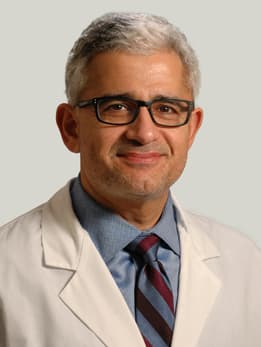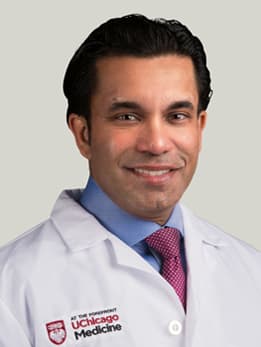Hybrid approach to heart and cardiovascular treatment speeds golfer's recovery

Although it could mean missing his weekly golf game, Leroy "Rocky" Cooper knew he had to get his heart fixed, and soon. He just had to find a way to get in, get it done, and get out without too much down time.
"I knew I had a problem and that it was getting worse," he said. "I thought maybe I needed some stents."
So, Cooper, who spends the warmer six months of the year in Frankfort, Illinois, and the colder six in Fort Myers Beach, Florida, went to a local medical center for tests. The team there had bad news. You need open-heart surgery, they told him.
He found this troubling. "My uncle had heart surgery last November," Cooper said. "He had to go back to the hospital soon afterwards for a collapsed lung. Six months later it still hurt. I thought: there must be a better way. So I did some research."
He was already tuned in to robotic surgery. About seven years ago, Cooper, now 61 years old, had been diagnosed with prostate cancer. He found a surgeon who removed the cancer using the DaVinci surgical robot. It did not require a major incision, just five small holes for the miniaturized surgical tools, tubes and a camera.
When he searched for robotic heart surgeons, though, he found this specialty was not nearly as common as robotic prostate specialists. But he soon came across Sandeep Nathan, MD, co-director of the cardiac catheterization laboratory. Working together, and in pairs, the three of them developed a plan.
They decided to perform the coronary bypass - known as LIMA-LAD - first, using the robot. The team carefully explained the process. Balkhy would insert his tools through five nickel-sized incisions to take part of the left internal mammary artery (LIMA) and use it to create a graft that would carry oxygen-rich blood past the partial blockage in Cooper's left anterior descending (LAD) artery.
"There are very few teams in a position to do this."
"That's the heart problem they call the 'widow maker,'" Cooper noted.
When Balkhy was done, the surgical tools would be removed and the tiny incisions closed. Nathan would then insert a catheter through the radial artery in the left wrist and maneuver it to the heart.
His first mission was simply to confirm that the bypass graft was reliably in place and functioning well. Then he would use an expandable balloon to open the partially clogged right coronary artery and install two wire-mesh stents to keep them open.
"I liked the idea that it was all done at once," Cooper said. "They call it the hybrid room, because they use it to combine different sorts of treatments, things that would normally be done on different days in separate rooms."
Although each physician has done hundreds of cases, they had never done the two procedures together, the same day in the same room. Cooper would be the first.
"Our approach was quite novel," Nathan said. "This all-in-one procedure is not performed on a routine basis. I don't know of another place that combines a totally endoscopic surgical approach with leading-edge interventional technique. But it makes perfect clinical sense."
"I'm glad you've volunteered for experimental surgery," was the response from Cooper's somewhat skeptical community-based physician when told of the innovative plan. He wished his patient luck.
Five small holes let golfer play 12
On Wednesday, July 9, Cooper played golf. Early the next morning, July 10, he checked into the hospital. He was wheeled to the hybrid room at 7:30 a.m.
"I got up and walked around the hospital for a couple hours. After a while they came looking for me, to tell me I would be discharged that afternoon."
Everything went according to plan. The combination of treatments took about four and a half hours: just under three hours for robotic surgery and about 90 minutes for angioplasty and stent placement. That evening, in his hospital bed, Cooper was pleased to find that despite having two teams unclogging and rerouting the arteries that delivered blood to his heart, he had little or no pain, "nothing an aspirin couldn't handle."
His only discomfort was a sore throat, caused by the breathing tube they put in place for his operation. He also had one not-unexpected disappointment. "The surgery," he said, "did not improve my golf game."
By Saturday morning, July 12, Cooper felt fine, eager to go home. "I was bored," he said. "I got up and walked around the hospital for a couple hours. After a while they came looking for me, to tell me I would be discharged that afternoon."
"I got out in two days," he marveled. "My uncle, the one who had surgery last November, called a few days later to ask how it went. 'You're up and around?' he said. 'Already?'"
Cooper insists he would definitely recommend the hybrid approach, bestowing upon his treatment team "five stars across the board." There was no pain, other than his sore throat. Recovery time was "virtually nil." His doctors, he said, "are way ahead of the game."
Plus, he added, they were not "suit doctors. They weren't stuffy. They would sit down and explain everything."
Just before he was discharged, Cooper's physicians -- pleased with the outcome and just a little proud of their accomplishment -- mentioned that he was the first patient to undergo simultaneous robotic bypass surgery and stent placements at the University of Chicago.
"There are very few teams in a position to do this," Balkhy noted, "but there may be a substantial number of patients for whom this is an appealing option."
The following Wednesday, Cooper did not play golf. But the next week, July 23, just 12 days after his pioneering operation, he was back on the course.
"It was a little too soon for all 18 holes," he acknowledged, "but I played 12. My arm hurt a little, and I got tired, but it was fine. It was good just to be out there."
Heart Surgery
At the University of Chicago Medicine, our heart surgeons are constantly refining their approach to surgery — taking steps to improve every aspect of the treatment experience for our patients.
Read more about heart surgery

